UCK Furniture: Applying Management Accounting for Performance
VerifiedAdded on 2023/01/12
|20
|2473
|92
Report
AI Summary
This report provides a detailed management accounting analysis of UCK Furniture, focusing on how different costing methods like absorption and marginal costing impact financial reporting and decision-making. The study examines inventory management, job costing, and price optimization systems, highlighting their benefits in tracking inventory, allocating costs, and determining optimal pricing strategies. It includes calculations of cost cards using both absorption and marginal costing methods, compares their merits and demerits, and presents an income statement for February. Furthermore, the report interprets net profit figures, conducts variable cost analysis, and evaluates inventory using LIFO, FIFO, and AVCO methods. The analysis extends to cash collection and disbursement schedules, budget cash calculations, and a comparative assessment of UCK Woodworks and UCK Furniture using Return on Capital Employed (ROCE), Asset Turnover Ratio, and Operating Profit Margin. Finally, the report emphasizes the importance of accounting techniques and planning tools in enhancing company performance and reducing financial problems.
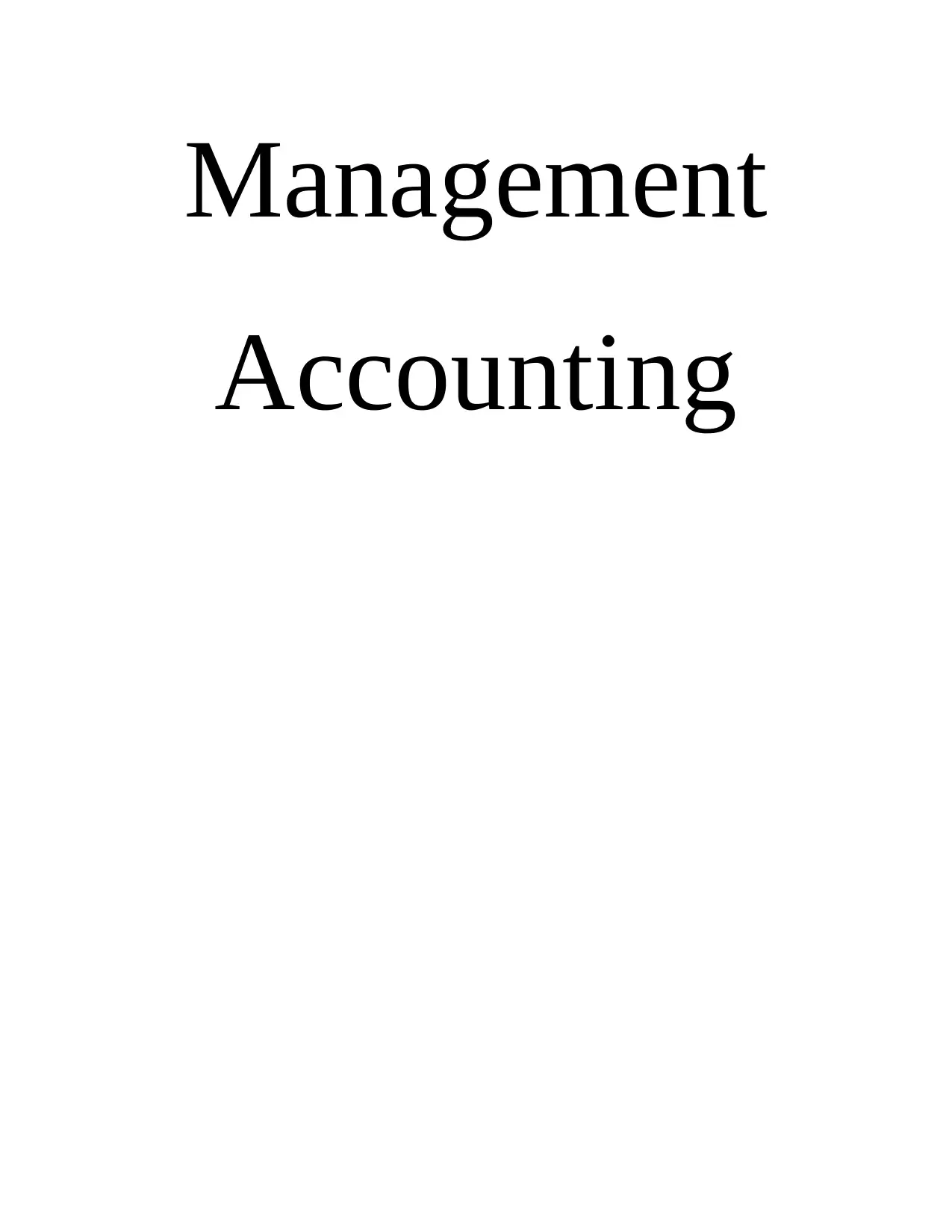
Management
Accounting
Accounting
Paraphrase This Document
Need a fresh take? Get an instant paraphrase of this document with our AI Paraphraser
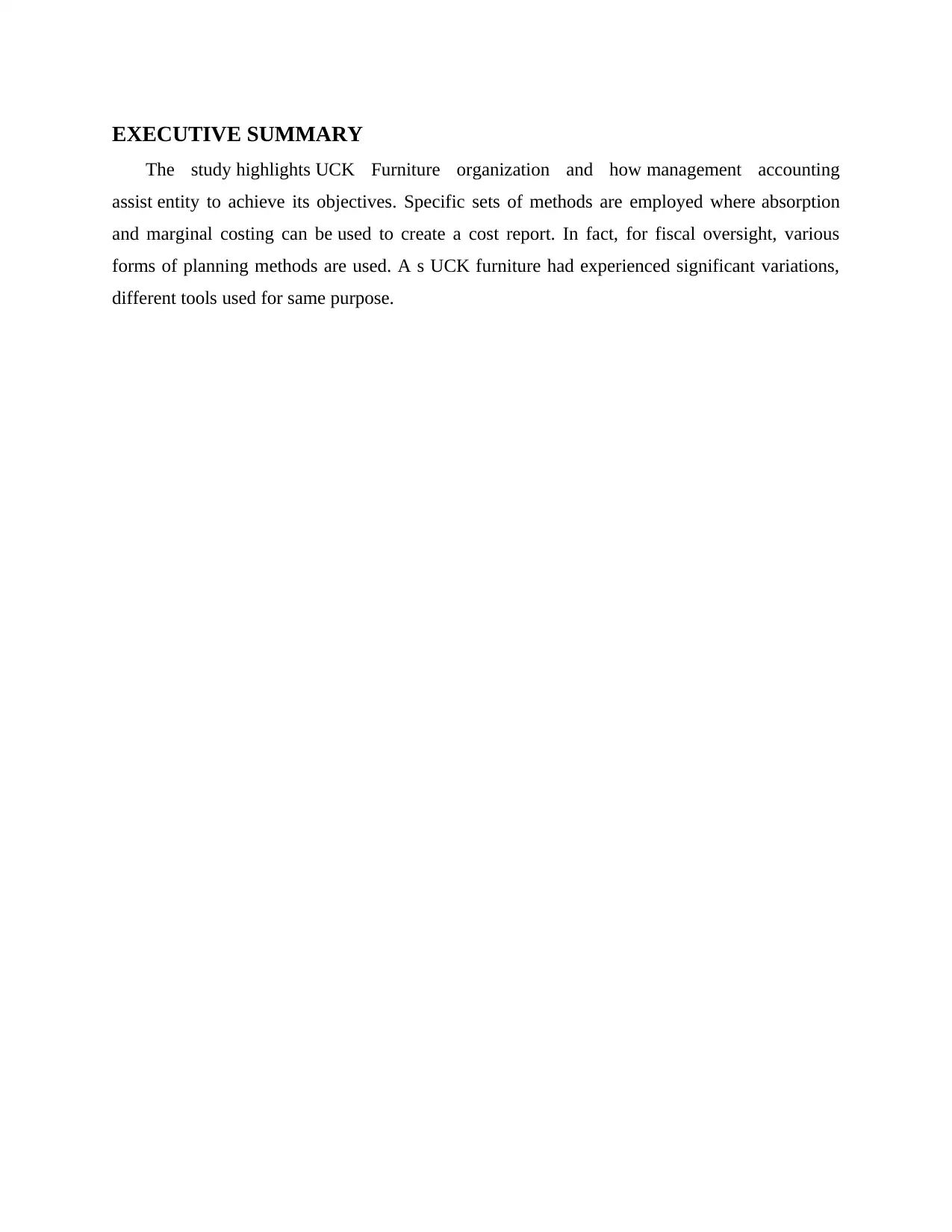
EXECUTIVE SUMMARY
The study highlights UCK Furniture organization and how management accounting
assist entity to achieve its objectives. Specific sets of methods are employed where absorption
and marginal costing can be used to create a cost report. In fact, for fiscal oversight, various
forms of planning methods are used. A s UCK furniture had experienced significant variations,
different tools used for same purpose.
The study highlights UCK Furniture organization and how management accounting
assist entity to achieve its objectives. Specific sets of methods are employed where absorption
and marginal costing can be used to create a cost report. In fact, for fiscal oversight, various
forms of planning methods are used. A s UCK furniture had experienced significant variations,
different tools used for same purpose.
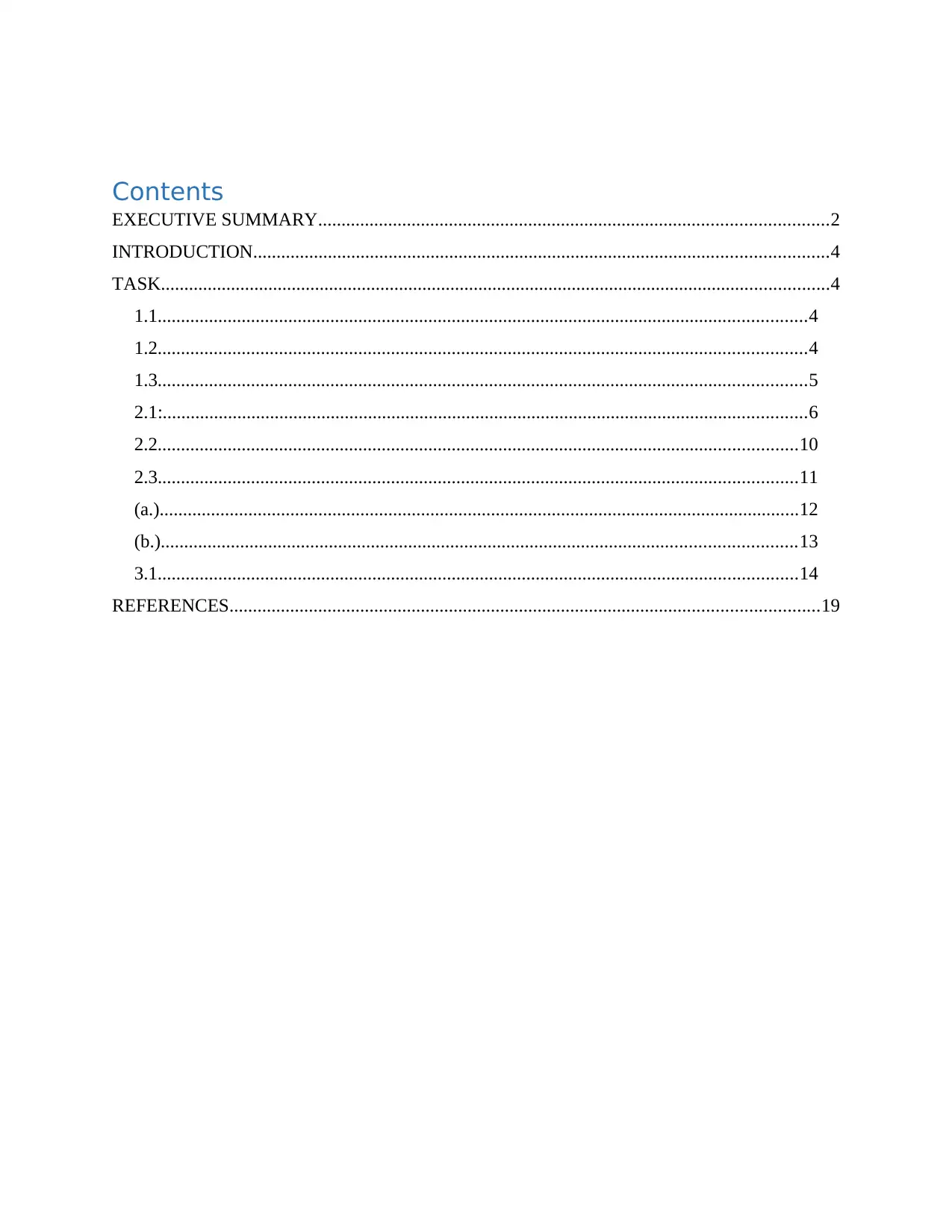
Contents
EXECUTIVE SUMMARY.............................................................................................................2
INTRODUCTION...........................................................................................................................4
TASK...............................................................................................................................................4
1.1...........................................................................................................................................4
1.2...........................................................................................................................................4
1.3...........................................................................................................................................5
2.1:..........................................................................................................................................6
2.2.........................................................................................................................................10
2.3.........................................................................................................................................11
(a.).........................................................................................................................................12
(b.)........................................................................................................................................13
3.1.........................................................................................................................................14
REFERENCES..............................................................................................................................19
EXECUTIVE SUMMARY.............................................................................................................2
INTRODUCTION...........................................................................................................................4
TASK...............................................................................................................................................4
1.1...........................................................................................................................................4
1.2...........................................................................................................................................4
1.3...........................................................................................................................................5
2.1:..........................................................................................................................................6
2.2.........................................................................................................................................10
2.3.........................................................................................................................................11
(a.).........................................................................................................................................12
(b.)........................................................................................................................................13
3.1.........................................................................................................................................14
REFERENCES..............................................................................................................................19
⊘ This is a preview!⊘
Do you want full access?
Subscribe today to unlock all pages.

Trusted by 1+ million students worldwide
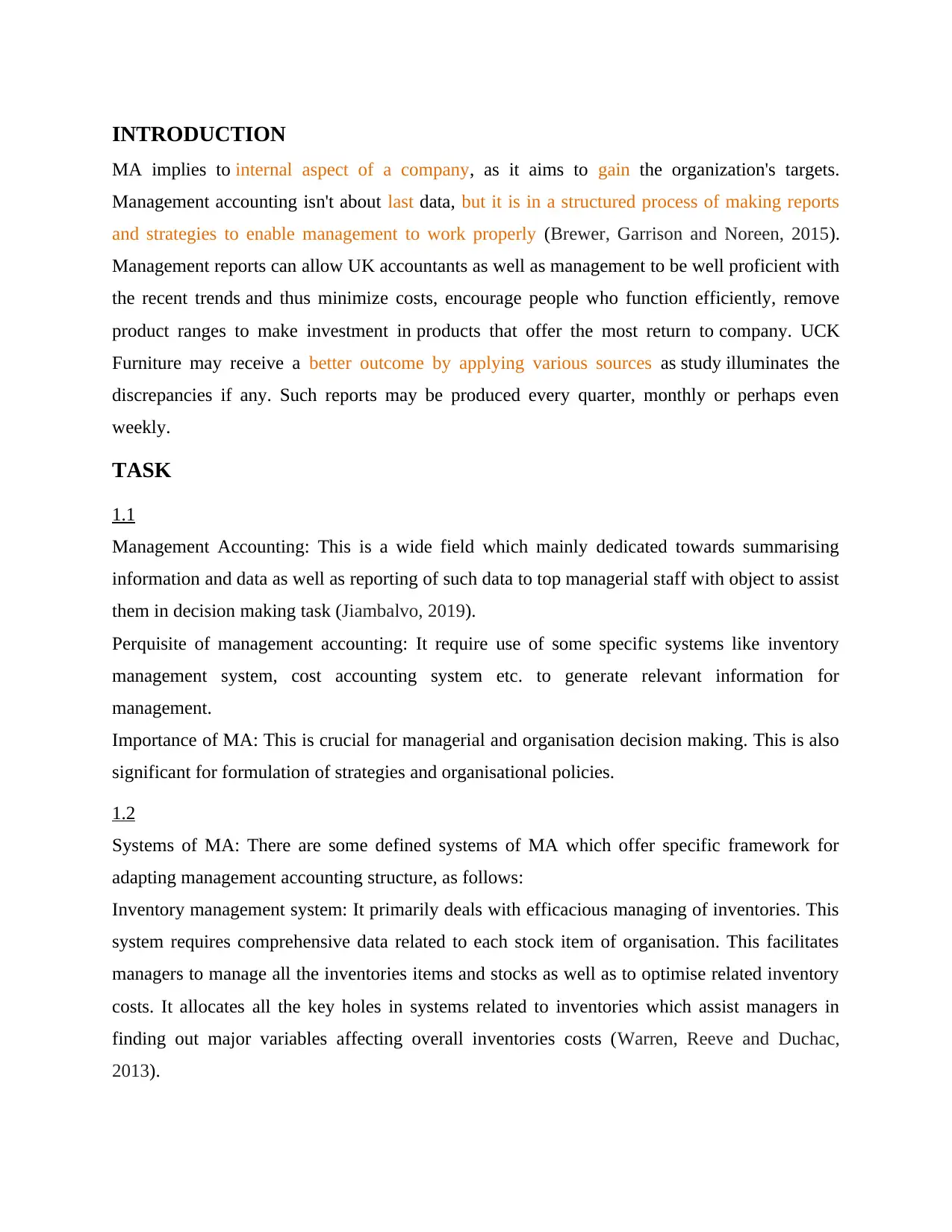
INTRODUCTION
MA implies to internal aspect of a company, as it aims to gain the organization's targets.
Management accounting isn't about last data, but it is in a structured process of making reports
and strategies to enable management to work properly (Brewer, Garrison and Noreen, 2015).
Management reports can allow UK accountants as well as management to be well proficient with
the recent trends and thus minimize costs, encourage people who function efficiently, remove
product ranges to make investment in products that offer the most return to company. UCK
Furniture may receive a better outcome by applying various sources as study illuminates the
discrepancies if any. Such reports may be produced every quarter, monthly or perhaps even
weekly.
TASK
1.1
Management Accounting: This is a wide field which mainly dedicated towards summarising
information and data as well as reporting of such data to top managerial staff with object to assist
them in decision making task (Jiambalvo, 2019).
Perquisite of management accounting: It require use of some specific systems like inventory
management system, cost accounting system etc. to generate relevant information for
management.
Importance of MA: This is crucial for managerial and organisation decision making. This is also
significant for formulation of strategies and organisational policies.
1.2
Systems of MA: There are some defined systems of MA which offer specific framework for
adapting management accounting structure, as follows:
Inventory management system: It primarily deals with efficacious managing of inventories. This
system requires comprehensive data related to each stock item of organisation. This facilitates
managers to manage all the inventories items and stocks as well as to optimise related inventory
costs. It allocates all the key holes in systems related to inventories which assist managers in
finding out major variables affecting overall inventories costs (Warren, Reeve and Duchac,
2013).
MA implies to internal aspect of a company, as it aims to gain the organization's targets.
Management accounting isn't about last data, but it is in a structured process of making reports
and strategies to enable management to work properly (Brewer, Garrison and Noreen, 2015).
Management reports can allow UK accountants as well as management to be well proficient with
the recent trends and thus minimize costs, encourage people who function efficiently, remove
product ranges to make investment in products that offer the most return to company. UCK
Furniture may receive a better outcome by applying various sources as study illuminates the
discrepancies if any. Such reports may be produced every quarter, monthly or perhaps even
weekly.
TASK
1.1
Management Accounting: This is a wide field which mainly dedicated towards summarising
information and data as well as reporting of such data to top managerial staff with object to assist
them in decision making task (Jiambalvo, 2019).
Perquisite of management accounting: It require use of some specific systems like inventory
management system, cost accounting system etc. to generate relevant information for
management.
Importance of MA: This is crucial for managerial and organisation decision making. This is also
significant for formulation of strategies and organisational policies.
1.2
Systems of MA: There are some defined systems of MA which offer specific framework for
adapting management accounting structure, as follows:
Inventory management system: It primarily deals with efficacious managing of inventories. This
system requires comprehensive data related to each stock item of organisation. This facilitates
managers to manage all the inventories items and stocks as well as to optimise related inventory
costs. It allocates all the key holes in systems related to inventories which assist managers in
finding out major variables affecting overall inventories costs (Warren, Reeve and Duchac,
2013).
Paraphrase This Document
Need a fresh take? Get an instant paraphrase of this document with our AI Paraphraser
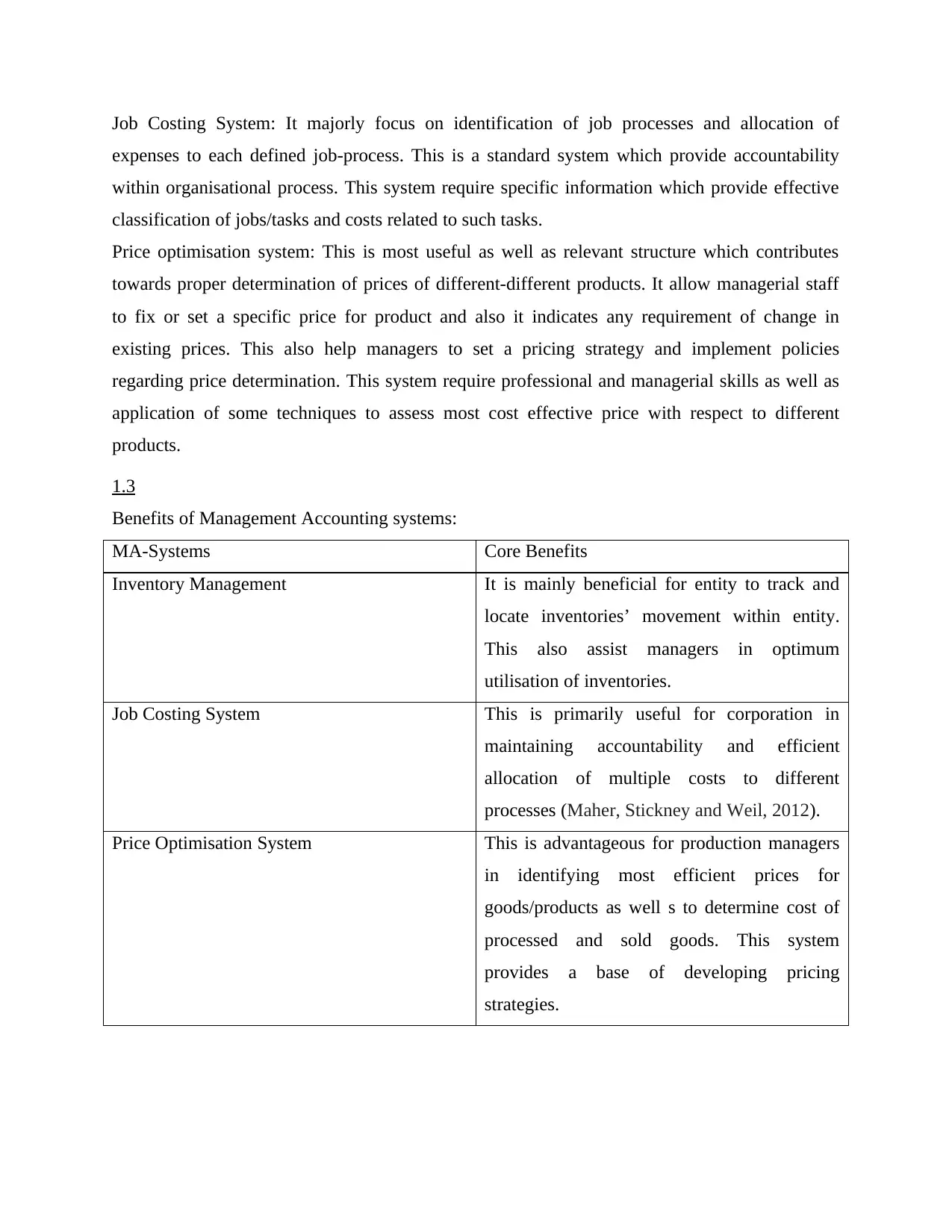
Job Costing System: It majorly focus on identification of job processes and allocation of
expenses to each defined job-process. This is a standard system which provide accountability
within organisational process. This system require specific information which provide effective
classification of jobs/tasks and costs related to such tasks.
Price optimisation system: This is most useful as well as relevant structure which contributes
towards proper determination of prices of different-different products. It allow managerial staff
to fix or set a specific price for product and also it indicates any requirement of change in
existing prices. This also help managers to set a pricing strategy and implement policies
regarding price determination. This system require professional and managerial skills as well as
application of some techniques to assess most cost effective price with respect to different
products.
1.3
Benefits of Management Accounting systems:
MA-Systems Core Benefits
Inventory Management It is mainly beneficial for entity to track and
locate inventories’ movement within entity.
This also assist managers in optimum
utilisation of inventories.
Job Costing System This is primarily useful for corporation in
maintaining accountability and efficient
allocation of multiple costs to different
processes (Maher, Stickney and Weil, 2012).
Price Optimisation System This is advantageous for production managers
in identifying most efficient prices for
goods/products as well s to determine cost of
processed and sold goods. This system
provides a base of developing pricing
strategies.
expenses to each defined job-process. This is a standard system which provide accountability
within organisational process. This system require specific information which provide effective
classification of jobs/tasks and costs related to such tasks.
Price optimisation system: This is most useful as well as relevant structure which contributes
towards proper determination of prices of different-different products. It allow managerial staff
to fix or set a specific price for product and also it indicates any requirement of change in
existing prices. This also help managers to set a pricing strategy and implement policies
regarding price determination. This system require professional and managerial skills as well as
application of some techniques to assess most cost effective price with respect to different
products.
1.3
Benefits of Management Accounting systems:
MA-Systems Core Benefits
Inventory Management It is mainly beneficial for entity to track and
locate inventories’ movement within entity.
This also assist managers in optimum
utilisation of inventories.
Job Costing System This is primarily useful for corporation in
maintaining accountability and efficient
allocation of multiple costs to different
processes (Maher, Stickney and Weil, 2012).
Price Optimisation System This is advantageous for production managers
in identifying most efficient prices for
goods/products as well s to determine cost of
processed and sold goods. This system
provides a base of developing pricing
strategies.
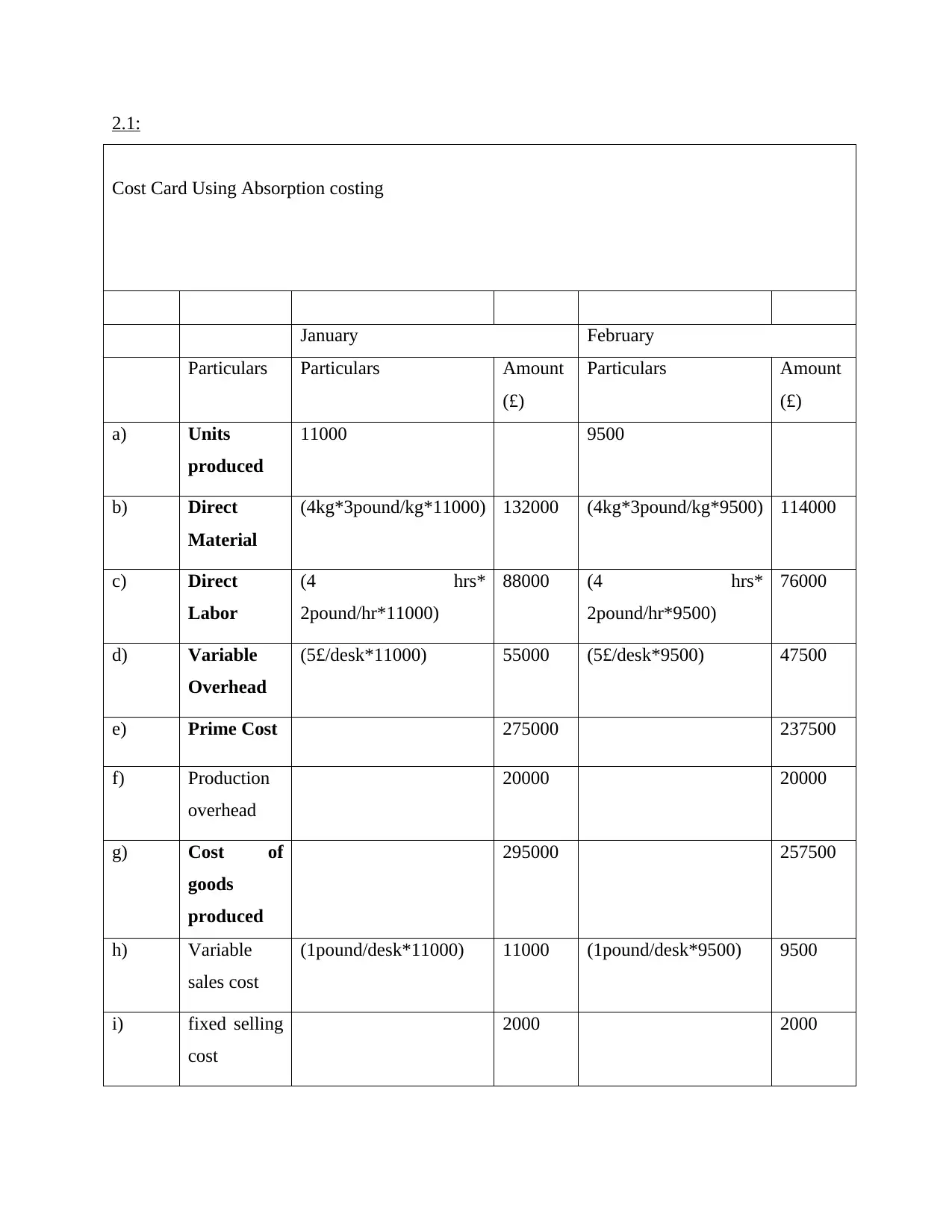
2.1:
Cost Card Using Absorption costing
January February
Particulars Particulars Amount
(£)
Particulars Amount
(£)
a) Units
produced
11000 9500
b) Direct
Material
(4kg*3pound/kg*11000) 132000 (4kg*3pound/kg*9500) 114000
c) Direct
Labor
(4 hrs*
2pound/hr*11000)
88000 (4 hrs*
2pound/hr*9500)
76000
d) Variable
Overhead
(5£/desk*11000) 55000 (5£/desk*9500) 47500
e) Prime Cost 275000 237500
f) Production
overhead
20000 20000
g) Cost of
goods
produced
295000 257500
h) Variable
sales cost
(1pound/desk*11000) 11000 (1pound/desk*9500) 9500
i) fixed selling
cost
2000 2000
Cost Card Using Absorption costing
January February
Particulars Particulars Amount
(£)
Particulars Amount
(£)
a) Units
produced
11000 9500
b) Direct
Material
(4kg*3pound/kg*11000) 132000 (4kg*3pound/kg*9500) 114000
c) Direct
Labor
(4 hrs*
2pound/hr*11000)
88000 (4 hrs*
2pound/hr*9500)
76000
d) Variable
Overhead
(5£/desk*11000) 55000 (5£/desk*9500) 47500
e) Prime Cost 275000 237500
f) Production
overhead
20000 20000
g) Cost of
goods
produced
295000 257500
h) Variable
sales cost
(1pound/desk*11000) 11000 (1pound/desk*9500) 9500
i) fixed selling
cost
2000 2000
⊘ This is a preview!⊘
Do you want full access?
Subscribe today to unlock all pages.

Trusted by 1+ million students worldwide
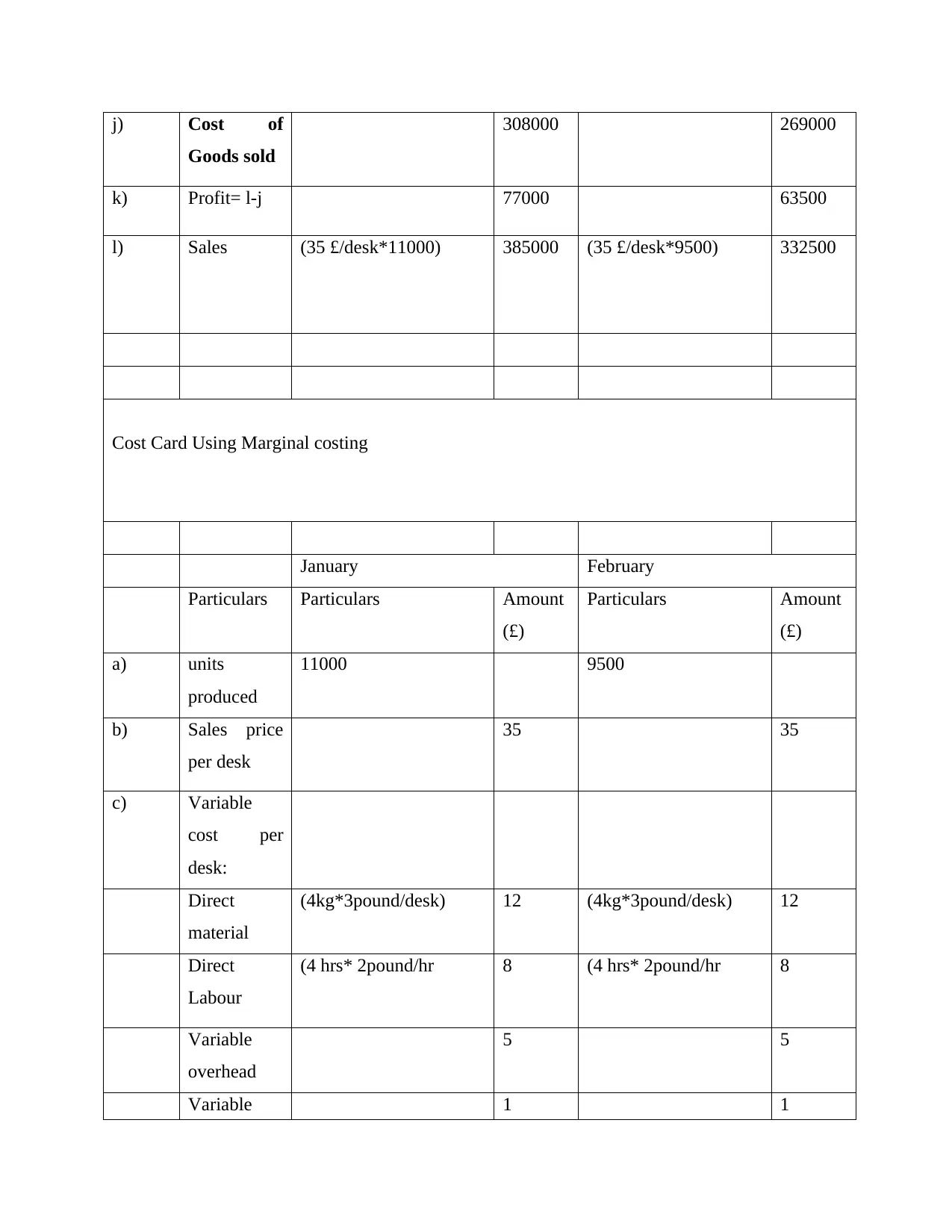
j) Cost of
Goods sold
308000 269000
k) Profit= l-j 77000 63500
l) Sales (35 £/desk*11000) 385000 (35 £/desk*9500) 332500
Cost Card Using Marginal costing
January February
Particulars Particulars Amount
(£)
Particulars Amount
(£)
a) units
produced
11000 9500
b) Sales price
per desk
35 35
c) Variable
cost per
desk:
Direct
material
(4kg*3pound/desk) 12 (4kg*3pound/desk) 12
Direct
Labour
(4 hrs* 2pound/hr 8 (4 hrs* 2pound/hr 8
Variable
overhead
5 5
Variable 1 1
Goods sold
308000 269000
k) Profit= l-j 77000 63500
l) Sales (35 £/desk*11000) 385000 (35 £/desk*9500) 332500
Cost Card Using Marginal costing
January February
Particulars Particulars Amount
(£)
Particulars Amount
(£)
a) units
produced
11000 9500
b) Sales price
per desk
35 35
c) Variable
cost per
desk:
Direct
material
(4kg*3pound/desk) 12 (4kg*3pound/desk) 12
Direct
Labour
(4 hrs* 2pound/hr 8 (4 hrs* 2pound/hr 8
Variable
overhead
5 5
Variable 1 1
Paraphrase This Document
Need a fresh take? Get an instant paraphrase of this document with our AI Paraphraser
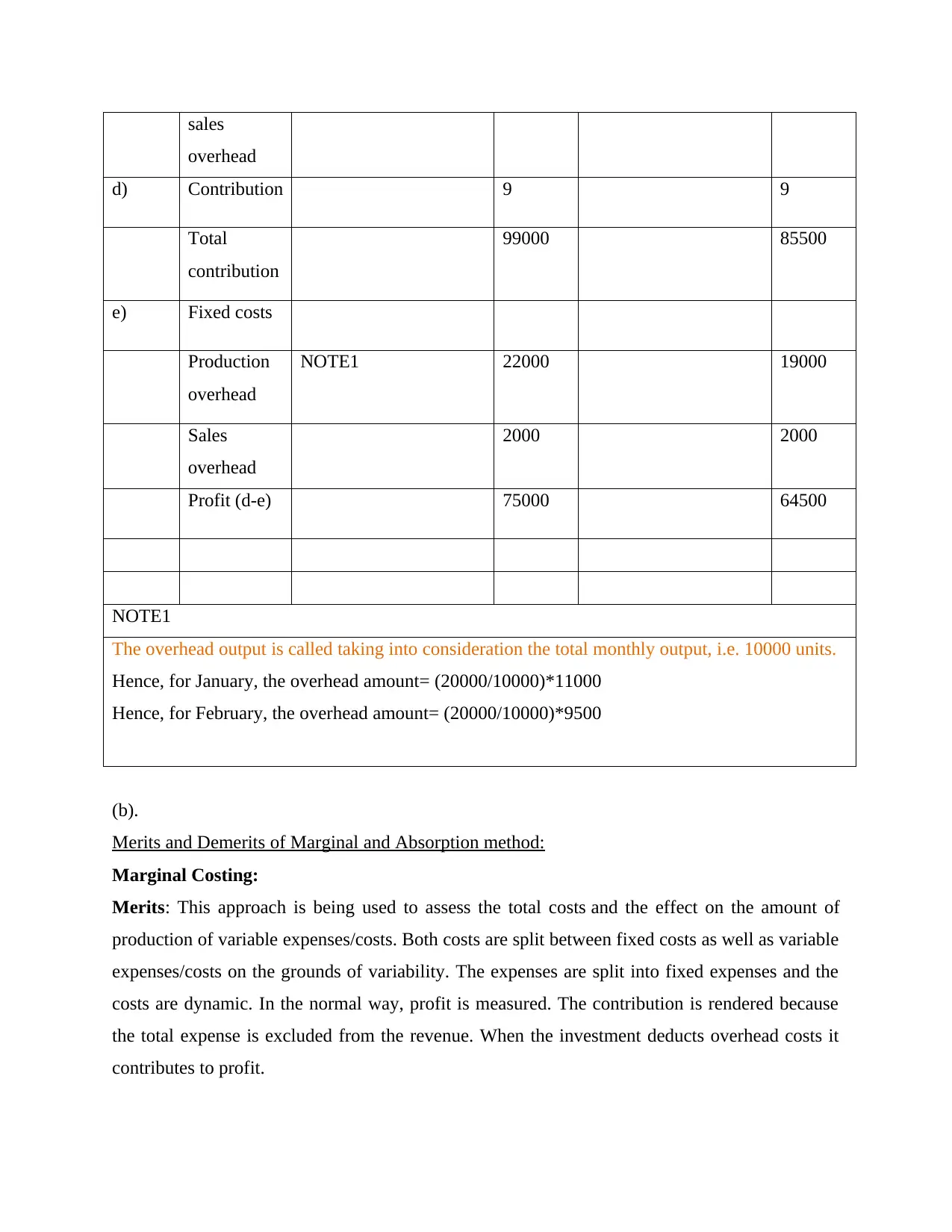
sales
overhead
d) Contribution 9 9
Total
contribution
99000 85500
e) Fixed costs
Production
overhead
NOTE1 22000 19000
Sales
overhead
2000 2000
Profit (d-e) 75000 64500
NOTE1
The overhead output is called taking into consideration the total monthly output, i.e. 10000 units.
Hence, for January, the overhead amount= (20000/10000)*11000
Hence, for February, the overhead amount= (20000/10000)*9500
(b).
Merits and Demerits of Marginal and Absorption method:
Marginal Costing:
Merits: This approach is being used to assess the total costs and the effect on the amount of
production of variable expenses/costs. Both costs are split between fixed costs as well as variable
expenses/costs on the grounds of variability. The expenses are split into fixed expenses and the
costs are dynamic. In the normal way, profit is measured. The contribution is rendered because
the total expense is excluded from the revenue. When the investment deducts overhead costs it
contributes to profit.
overhead
d) Contribution 9 9
Total
contribution
99000 85500
e) Fixed costs
Production
overhead
NOTE1 22000 19000
Sales
overhead
2000 2000
Profit (d-e) 75000 64500
NOTE1
The overhead output is called taking into consideration the total monthly output, i.e. 10000 units.
Hence, for January, the overhead amount= (20000/10000)*11000
Hence, for February, the overhead amount= (20000/10000)*9500
(b).
Merits and Demerits of Marginal and Absorption method:
Marginal Costing:
Merits: This approach is being used to assess the total costs and the effect on the amount of
production of variable expenses/costs. Both costs are split between fixed costs as well as variable
expenses/costs on the grounds of variability. The expenses are split into fixed expenses and the
costs are dynamic. In the normal way, profit is measured. The contribution is rendered because
the total expense is excluded from the revenue. When the investment deducts overhead costs it
contributes to profit.
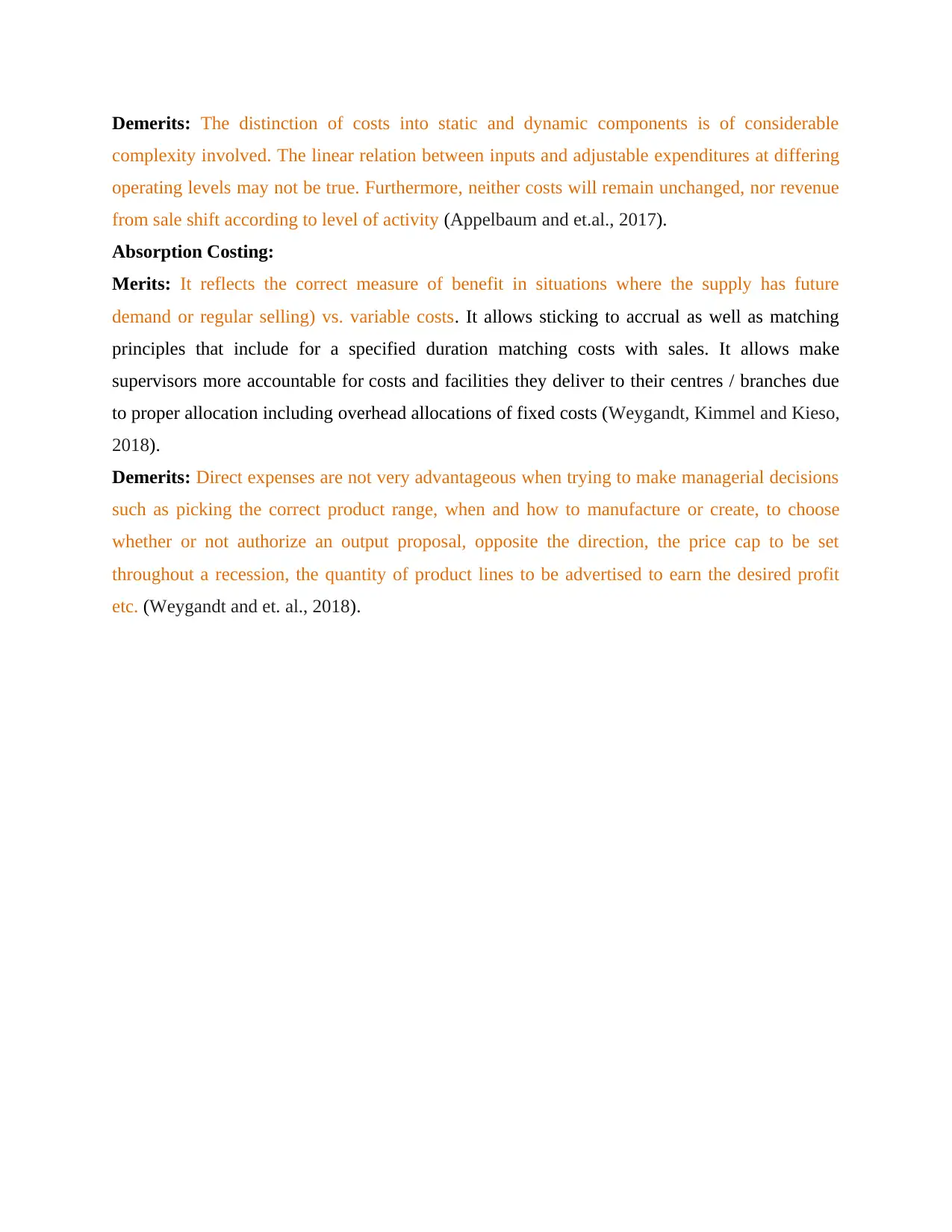
Demerits: The distinction of costs into static and dynamic components is of considerable
complexity involved. The linear relation between inputs and adjustable expenditures at differing
operating levels may not be true. Furthermore, neither costs will remain unchanged, nor revenue
from sale shift according to level of activity (Appelbaum and et.al., 2017).
Absorption Costing:
Merits: It reflects the correct measure of benefit in situations where the supply has future
demand or regular selling) vs. variable costs. It allows sticking to accrual as well as matching
principles that include for a specified duration matching costs with sales. It allows make
supervisors more accountable for costs and facilities they deliver to their centres / branches due
to proper allocation including overhead allocations of fixed costs (Weygandt, Kimmel and Kieso,
2018).
Demerits: Direct expenses are not very advantageous when trying to make managerial decisions
such as picking the correct product range, when and how to manufacture or create, to choose
whether or not authorize an output proposal, opposite the direction, the price cap to be set
throughout a recession, the quantity of product lines to be advertised to earn the desired profit
etc. (Weygandt and et. al., 2018).
complexity involved. The linear relation between inputs and adjustable expenditures at differing
operating levels may not be true. Furthermore, neither costs will remain unchanged, nor revenue
from sale shift according to level of activity (Appelbaum and et.al., 2017).
Absorption Costing:
Merits: It reflects the correct measure of benefit in situations where the supply has future
demand or regular selling) vs. variable costs. It allows sticking to accrual as well as matching
principles that include for a specified duration matching costs with sales. It allows make
supervisors more accountable for costs and facilities they deliver to their centres / branches due
to proper allocation including overhead allocations of fixed costs (Weygandt, Kimmel and Kieso,
2018).
Demerits: Direct expenses are not very advantageous when trying to make managerial decisions
such as picking the correct product range, when and how to manufacture or create, to choose
whether or not authorize an output proposal, opposite the direction, the price cap to be set
throughout a recession, the quantity of product lines to be advertised to earn the desired profit
etc. (Weygandt and et. al., 2018).
⊘ This is a preview!⊘
Do you want full access?
Subscribe today to unlock all pages.

Trusted by 1+ million students worldwide
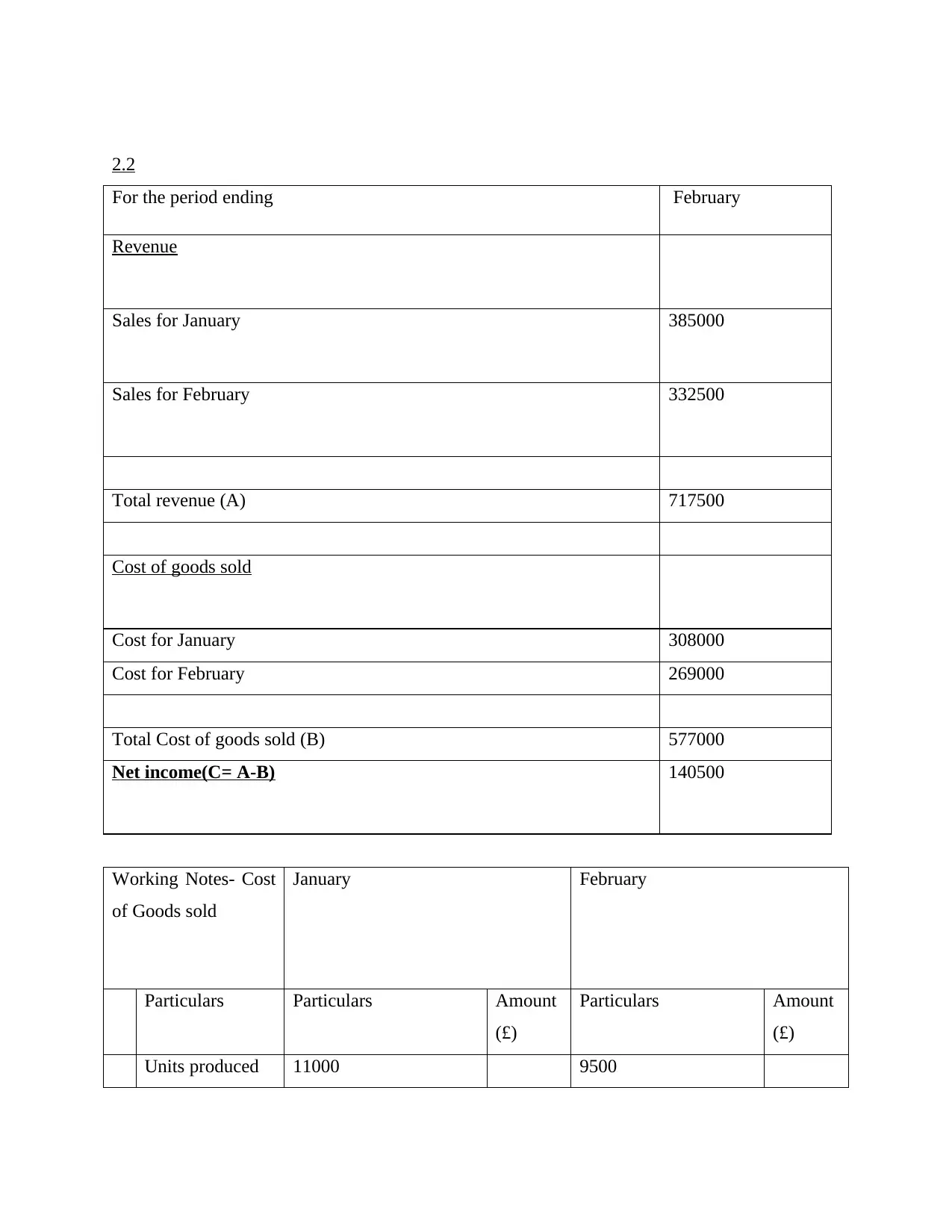
2.2
For the period ending February
Revenue
Sales for January 385000
Sales for February 332500
Total revenue (A) 717500
Cost of goods sold
Cost for January 308000
Cost for February 269000
Total Cost of goods sold (B) 577000
Net income(C= A-B) 140500
Working Notes- Cost
of Goods sold
January February
Particulars Particulars Amount
(£)
Particulars Amount
(£)
Units produced 11000 9500
For the period ending February
Revenue
Sales for January 385000
Sales for February 332500
Total revenue (A) 717500
Cost of goods sold
Cost for January 308000
Cost for February 269000
Total Cost of goods sold (B) 577000
Net income(C= A-B) 140500
Working Notes- Cost
of Goods sold
January February
Particulars Particulars Amount
(£)
Particulars Amount
(£)
Units produced 11000 9500
Paraphrase This Document
Need a fresh take? Get an instant paraphrase of this document with our AI Paraphraser
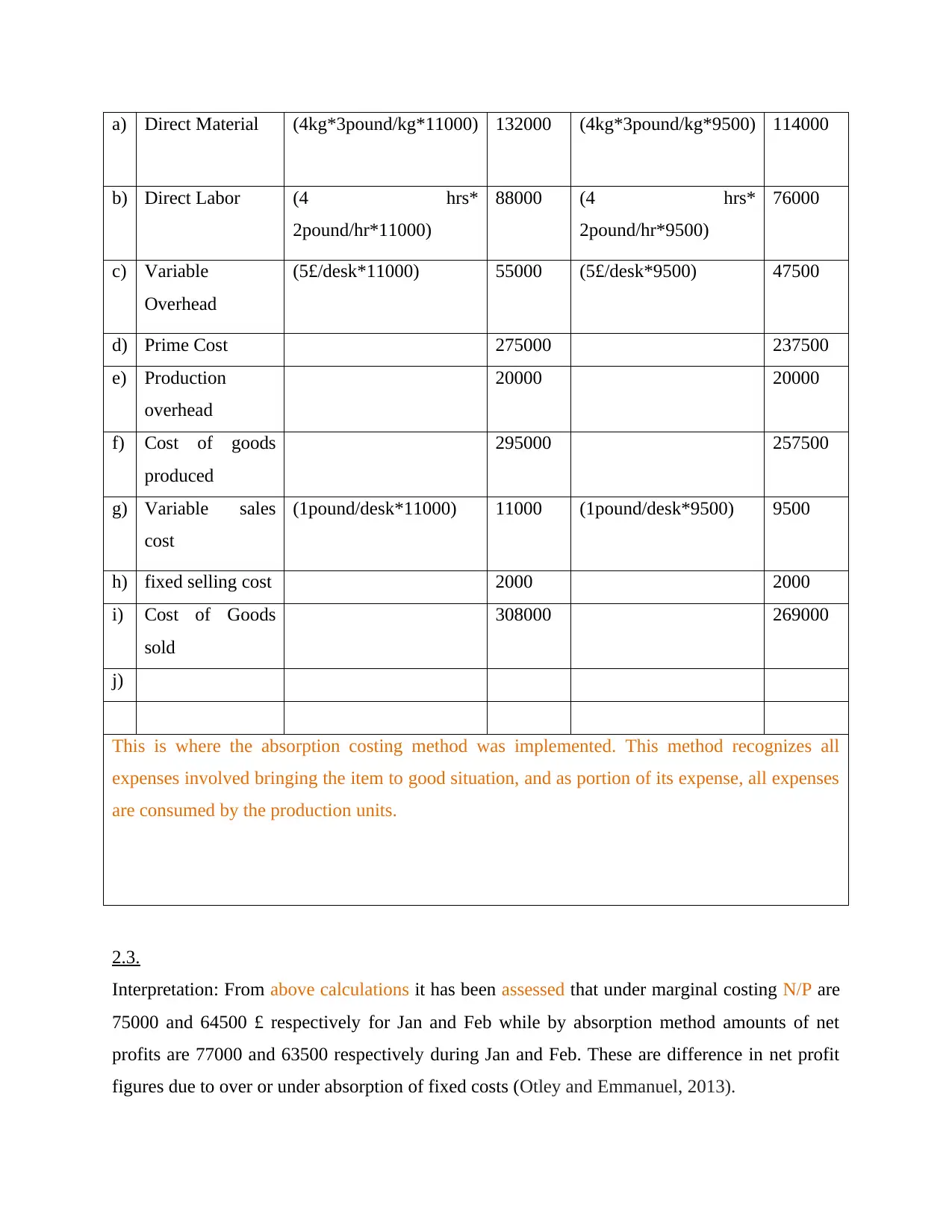
a) Direct Material (4kg*3pound/kg*11000) 132000 (4kg*3pound/kg*9500) 114000
b) Direct Labor (4 hrs*
2pound/hr*11000)
88000 (4 hrs*
2pound/hr*9500)
76000
c) Variable
Overhead
(5£/desk*11000) 55000 (5£/desk*9500) 47500
d) Prime Cost 275000 237500
e) Production
overhead
20000 20000
f) Cost of goods
produced
295000 257500
g) Variable sales
cost
(1pound/desk*11000) 11000 (1pound/desk*9500) 9500
h) fixed selling cost 2000 2000
i) Cost of Goods
sold
308000 269000
j)
This is where the absorption costing method was implemented. This method recognizes all
expenses involved bringing the item to good situation, and as portion of its expense, all expenses
are consumed by the production units.
2.3.
Interpretation: From above calculations it has been assessed that under marginal costing N/P are
75000 and 64500 £ respectively for Jan and Feb while by absorption method amounts of net
profits are 77000 and 63500 respectively during Jan and Feb. These are difference in net profit
figures due to over or under absorption of fixed costs (Otley and Emmanuel, 2013).
b) Direct Labor (4 hrs*
2pound/hr*11000)
88000 (4 hrs*
2pound/hr*9500)
76000
c) Variable
Overhead
(5£/desk*11000) 55000 (5£/desk*9500) 47500
d) Prime Cost 275000 237500
e) Production
overhead
20000 20000
f) Cost of goods
produced
295000 257500
g) Variable sales
cost
(1pound/desk*11000) 11000 (1pound/desk*9500) 9500
h) fixed selling cost 2000 2000
i) Cost of Goods
sold
308000 269000
j)
This is where the absorption costing method was implemented. This method recognizes all
expenses involved bringing the item to good situation, and as portion of its expense, all expenses
are consumed by the production units.
2.3.
Interpretation: From above calculations it has been assessed that under marginal costing N/P are
75000 and 64500 £ respectively for Jan and Feb while by absorption method amounts of net
profits are 77000 and 63500 respectively during Jan and Feb. These are difference in net profit
figures due to over or under absorption of fixed costs (Otley and Emmanuel, 2013).
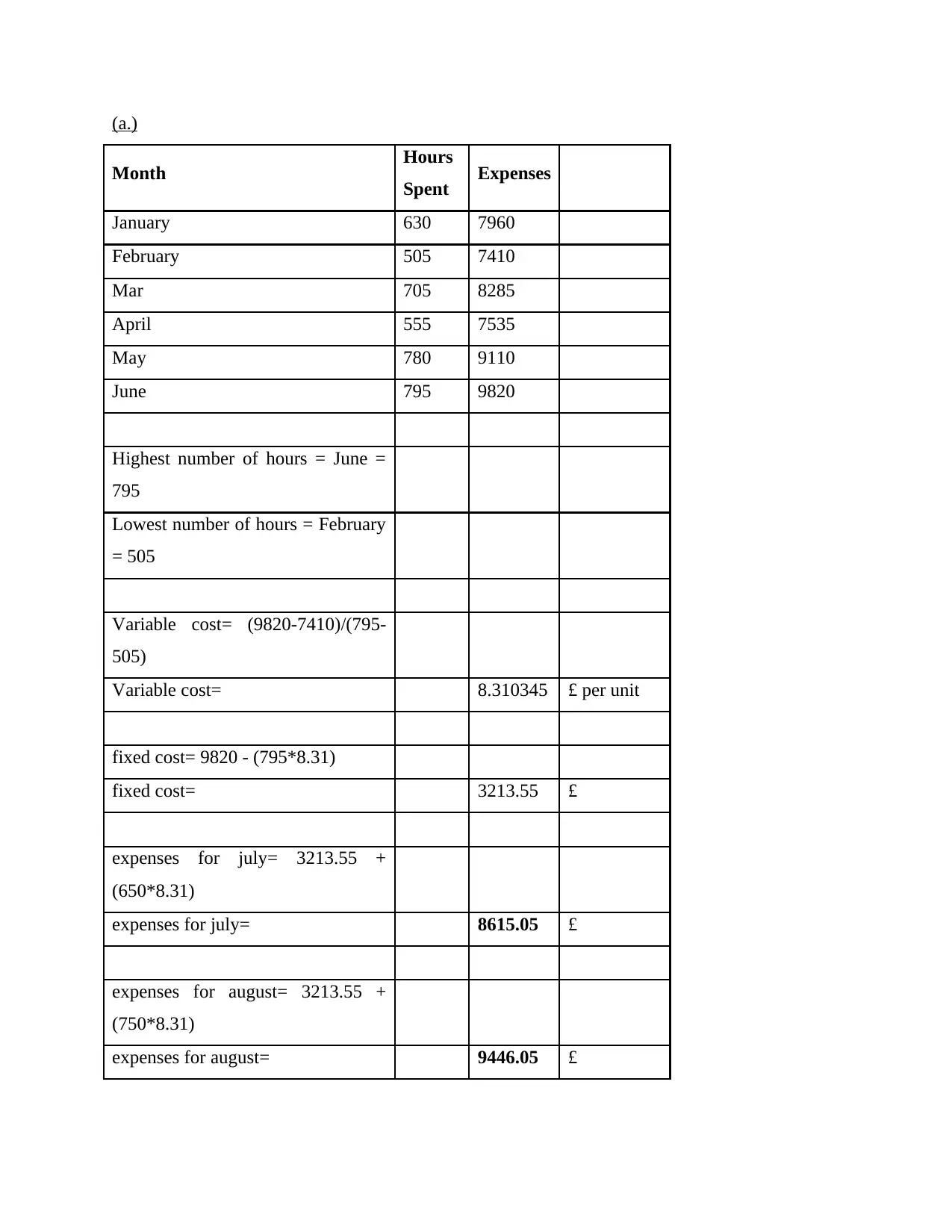
(a.)
Month Hours
Spent Expenses
January 630 7960
February 505 7410
Mar 705 8285
April 555 7535
May 780 9110
June 795 9820
Highest number of hours = June =
795
Lowest number of hours = February
= 505
Variable cost= (9820-7410)/(795-
505)
Variable cost= 8.310345 £ per unit
fixed cost= 9820 - (795*8.31)
fixed cost= 3213.55 £
expenses for july= 3213.55 +
(650*8.31)
expenses for july= 8615.05 £
expenses for august= 3213.55 +
(750*8.31)
expenses for august= 9446.05 £
Month Hours
Spent Expenses
January 630 7960
February 505 7410
Mar 705 8285
April 555 7535
May 780 9110
June 795 9820
Highest number of hours = June =
795
Lowest number of hours = February
= 505
Variable cost= (9820-7410)/(795-
505)
Variable cost= 8.310345 £ per unit
fixed cost= 9820 - (795*8.31)
fixed cost= 3213.55 £
expenses for july= 3213.55 +
(650*8.31)
expenses for july= 8615.05 £
expenses for august= 3213.55 +
(750*8.31)
expenses for august= 9446.05 £
⊘ This is a preview!⊘
Do you want full access?
Subscribe today to unlock all pages.

Trusted by 1+ million students worldwide
1 out of 20
Related Documents
Your All-in-One AI-Powered Toolkit for Academic Success.
+13062052269
info@desklib.com
Available 24*7 on WhatsApp / Email
![[object Object]](/_next/static/media/star-bottom.7253800d.svg)
Unlock your academic potential
Copyright © 2020–2025 A2Z Services. All Rights Reserved. Developed and managed by ZUCOL.





